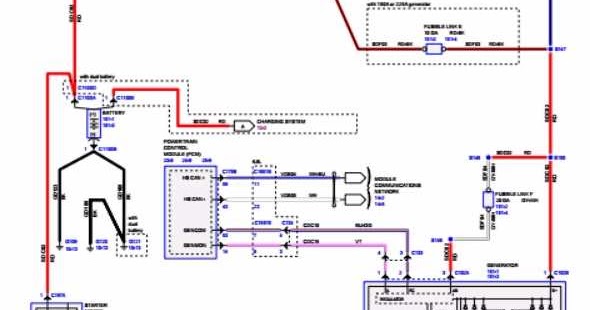Text & photos by Ken Styer
AIR CONDITIONING Manual A/C Wiring Diagram (1 of 2) for Ford Focus ZXW SE 2005 Manual A/C Wiring Diagram (2 of 2) for Ford Focus ZXW SE 2005ANTI-LOCK BRAKES Anti-lock Brakes Wiring Diagram, with Traction Control for Ford Focus ZXW SE 2005 Anti-lock Brakes Wiring Diagram, without Traction Control for All Wiring Diagrams for Ford Focus ZXW SE 2005. 2006 Ford Focus Fuse Diagrams 2006 Ford Focus Fuse Diagrams for Battery Junction Box and Central Junction Box. Find the 2006 Ford Focus Fuse Diagrams here. The battery junction box is located in the left rear corner of the engine compartment. The Central Junction Box is located on the lower left side of the dash. There’s lots more information.
Instructor, Ohio Technical College, Cleveland, OH
Every vehicle has it fans and its detractors, and every vehicle has its strong points and weak points. While the Ford Focus is no exception, it does soldier on and remains a popular vehicle. That means it will likely come into your shop with its own set of problems. Let's take the shock out of a few electrical problems in this popular vehicle. While not limited to a single model year, you can find these problems on 2000 and newer vehicles. Our photo car is a 2000 Focus Wagon.
2005 Ford Focus Electrical Diagram
PROBLEMATIC INSTRUMENT CLUSTER
Several problems in our Focus appear to be the same or similar, but have very different sources. The driver complaint will be an erratic dash board display. The information display may flicker, go out entirely, partly fail, or create odd displays. While electronic information displays have been known to do all of these things, avoid the temptation to start tearing the instrument cluster out for closer inspection. There are a few other things to check out first.
Our first problem is a bit of a rerun. The old Tempo/Topaz, and several other models shared a similar malady: the alternator connections. If you recall, or even if you don't, the older Fords have a three-wire electrical connector at the rear of the alternator that included the battery positive lead. Due to the fact these consisted of all flat connectors, they would work loose and/or start to wobble over time. This created a poor electrical connection due to a poor mechanical connection.

Ford Focus Wiring Harness
As the connection deteriorated, it wobbled to the point where the connections would start to arc. From there the connection would deteriorate very quickly. The result was a completely fried connector that usually resulted in an alternator failure and plug pigtail replacement. This was common enough that several aftermarket suppliers included a replacement pigtail along with a rebuilt alternator. You could also readily find them hanging in the parts store electrical section.
While the Focus connector is different, the condition is very similar, but with an added new twist. The Focus connector does not usually cause an alternator failure, but can cause a charging system problem. In addition, it installs gremlins.
With the newer electronics, electrical arcing and poor connections create strange behavior in many electrical circuits. In the Focus, for example, this commonly creates erratic dash instrument cluster operation. Yep, an underhood connection is now creating a dash display problem. The display will come and go, operate oddly, and sometimes flat out lie to you. Keep in mind, with the charging system warning on the dash, there is a direct tie between the two components. Combine that with frequency and rough electrical pulses, and you have the cause of the odd behavior.
WIGGLE TEST
While a helper watches the dash, reach behind the engine on the passenger side, and wiggle and twist the alternator connector. Ford calls this a wiggle test, and it is still as good now as it was when it was named. If the dash now behaves properly or gets worse while wiggling, you have found the culprit.
However, in many cases, you don't need to replace the plug and connectors. You may be able to remove corrosion or tighten up the contacts to repair the problem. Be sure to check for pin fit in the connector. Of course replacement is always a possibility. Don't make the mistake many techs make. Don't just fix it and let it go out the door. Apply the dielectric grease to the connector to prevent any repeat performances of the problem. Dielectric is critical for the longevity of almost any electrical repair on a vehicle. Skipping the dielectric grease will cause the car to come back in the future.[PAGEBREAK]
The kicker: The glitch may not be the plug or connection at all. If you have good connections, check the voltages. The red wire should be battery voltage with the key on engine off. The gray wire should present 9 volts and the blue wire 0 volts with KOEO (key on/ignition off). If the problem still comes and goes when pushing on the plug, the alternator likely has internal damaged, in which case you’ll need to replace the alternator.
HATCH HARNESS
Our next problem with our dash display is at the other end of the car. It is not really as much of a problem in our wagon as it is in the hatchback version. You may never see this in your customer’s car, but it could show up early in its life cycle. It depends on how the car is used. If the car primarily carries passengers and does not carry much cargo, you probably won't see this one. But if the hatch is opened frequently for groceries, tools, or girl scout cookies, this one hits home.
The wiring harness in the hinge/hatch opening area experiences quite a bit of flexing. The obvious problems involve the rear lighting systems, lift-gate release, rear wiper and defroster, etc. But again, turn signals and warning lights tie into the dash. And once again, arcing creates frequencies and poor voltages that confuse our poor instrument cluster. In many cars, the first symptoms would be noticed by those following the car, but in this case the driver may see the dash act oddly before the rear lighting problems are detected.
Over time, the hatch harness wires get soft and weak. Soon, you have the hard-to-find open circuit. But as the commercial says, wait there's more! The wires can rub through their insulation and create shorts. Both the opens and shorts are intermittent in many cases. Once again the wiggle test is very helpful.
Here is a bit of caution. When you find one of these problems, do not attempt to perform a repair in the hatch area. The repair splice will be stiffer than the original harness, and will resist flexing when the hatch is opened, thus shortening the life of the repair a great deal, and could cause even more problems with associated wiring. Instead, remove the damaged wire from the hatch hinge area, and replace it with a new wire. Make the splices outsideof the area of movement. While that does involve removing several interior panels to gain access, the result will be a longer lasting and better repair.

IGNITION SWITCH GLITCH

Wiring Diagram For 2009 Ford Focus
Once again, the entire dash display may simply behave oddly. As a matter of fact, sometimes the dash will be fine but the engine just won't start. Perhaps the dash is entirely dead, and the engine may or may not start. Once again, we are due for a wiggle test, but not to the wiring harness or connectors. Instead wiggle and bounce the ignition key in order to “wiggle” the ignition switch. The switch contacts become worn and start to make poor contact. Just a good bump in the road can change what touches and what does not. Shorting is not an issue, and the problem may simply involve poor contact causing circuits to come and go at random.[PAGEBREAK]
Naturally, if this is the case, replace the ignition switch. Be sure the battery is disconnected. Remove the lower steering column shroud, and using a thin screwdriver, release the clips hold in the top shroud, and remove the shroud. If the car is equipped with a lock lever, remove the lever. Disconnect the electrical connector. Release the clips holding the ignition switch, and remove the switch. Install the new switch in the reverse order.
Ford Focus Wiring Diagram Pdf
Sometimes on the performance version of the Focus, we have seen the ignition switch operate just fine, and all of the dash displays are okay, but it won't crank. Before you are inclined to replace the switch, check the basics by inspecting for loose/corroded battery cables and connections (at the battery, ground and starter). Once again, after the cables are cleaned and tightened, a little dielectric grease goes a long way to prevent future problems. Of course this is not limited to the performance version, it could happen on any Focus, or any vehicle for that matter.
YET ANOTHER COMMON PROBLEM
While under the hood, inspect the cruise control unit, which is located on the firewall. The problem is that the cruise unit is mounted directly under the low pressure line for the air conditioning. As you know, the low pressure line creates moisture during condensation. Unfortunately, condensation drips, and in this case it drips directly onto the cruise control unit. This can create two different problems.
The first one is the electrical connectors to the cruise unit. Most of the time the weather pack connectors do the job, and prevent damage. If not, clean the connections and reach for the dielectric grease when putting it back together to prevent a rerun.
However, the more likely problem with the cruise control system may not be electrical at all. Instead you may find that the throttle cable from the cruise had all the water it can handle, and the cable is rusted solid, requiring a cable replacement.